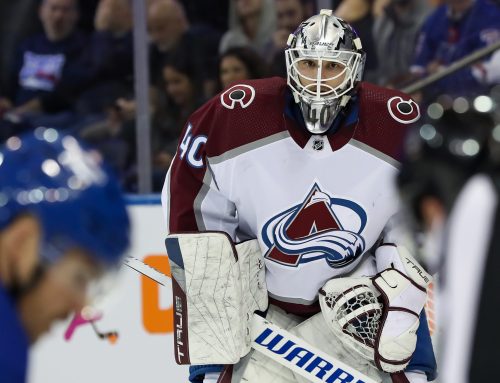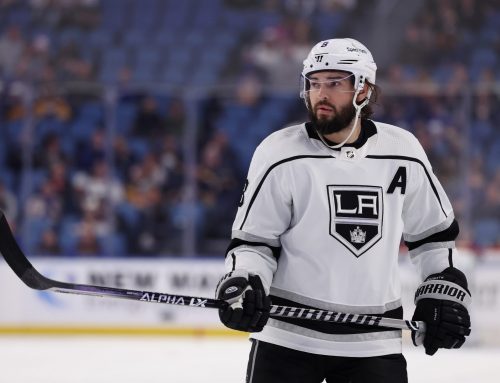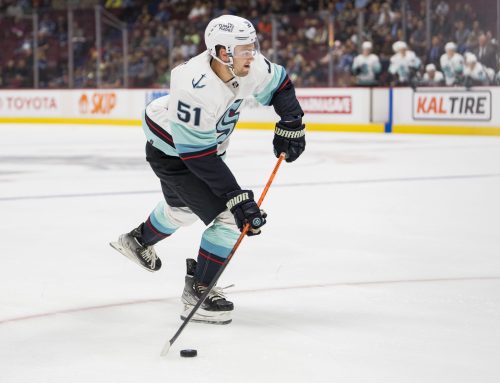Analysis: P.K. Subban and Adam Larsson
Doran Libin
2016-07-04

Doran Libin weighs in on what's ahead for PK Subban and Adam Larsson
Just before the opening of free agency the NHL was rocked by two massive trades that were nearly universally panned as heavily favoring one of the teams involved. Three of the four players to switch teams are top fantasy assets at their position and the fourth was Adam Larsson. This week the column takes a deep dive in to the two players who moved west in the two deals and look at how they might be affected by their new situations.
Despite playing on teams that scored at very similar rates overall Subban was on the ice for half a goal more per 60 minutes than Shea Weber. While they both had positive goals for per 60 relative rates Subban’s was almost twice that of Weber’s. Subban also had a much larger relative shot rate than Weber, suggesting that even though he had a higher on-ice shooting percentage that it was not solely responsible for better goal rate. The higher shot rate goes a long way to explaining the fact that the Canadiens had a higher expected goal rate with Subban on the ice than the Predators had with Weber on the ice. This suggests that Subban is much more proficient at creating offense for his teammates than Weber is for his. This ability to drive the offense does come at a bit of a cost to Subban’s defensive game Montreal allowed two more shots per 60 minutes at even strength with Subban on the ice than Nashville did with Weber on the ice. This is not just a team issue, as Subban has a much higher relative shots against per 60 minutes and has an adverse effect on his team’s expected goals against per 60 minutes. The good news is that Subban has a much bigger positive effect on his team’s offense than he does a negative effect on his team’s defense. Subban’s issues on defense are fairly minor but may be exaggerated should Rinne’s level of play continue to slide.
Weber and Subban played approximately the same number of total minutes however Subban’s were had a slightly more offensive focus to them. Subban got more time on the power play than Weber and less time on the penalty kill than Weber. With Nashville having a significantly better overall defense corps than Montreal Subban could see even more offensive centric minutes should Laviolette decide not to replace Subban on a pairing with Josi. Nashville, with its deeper defense, has better options defensively and thus the ability to give Subban a more offensive role. The biggest change for Subban could be on the power play as Nashville tends to get a higher percentage of their power play shots from the point. Weber had 180 more attempted shots on the power play over the last three years as is evidenced by Weber taking more than two more shots per 60 on the power play. thus even though he gets a higher percentage of his shots through unblocked Subban is still sure to benefit from the greater focus on him for offense on the power play. Even though Weber and Subban have very similar point totals though a much higher percentage of Weber’s power play points were goals. The difference in power play goals almost entirely explains the overall difference in goals between the two defensemen as Weber scored two more goals at even strength but 14 more overall. This should lead to a return of the double-digit goal days for Subban, which immediately adds value in many leagues. Furthermore, a power play featuring two of the best puck moving defensemen in the league should make the Nashville power play even more lethal as it can only help gain the offensive zone easier.
There are other reasons to expect Subban to score even more goals this year as he was on pace to take 200 shots last season yet he still only scored six goals. Part of the reason for Subban’s low goal scoring total was a drop in his shooting percentage from 8.8% in 2014/15 to 3.4% in 2015/16. Subban has been in the NHL for six years and his shooting percentage has dropped under five percent every second year. Even if there were not this weird trend it would still be smart to bet on Subban’s shooting percentage to rebound. The combination of his low shooting percentage and the move to the Nashville power play could see Subban finally reach the 20-goal mark. Subban has assisted on at least 30% of the goals scored while he is on the ice in each of the last three years, if he scored more on the power play this year his assist rate could drop a little, although he should stay close to 40 assists. Altogether this adds up to Subban having the potential to regain a place amongst the top five scoring defensemen. This is not a big shift for Subban but it has all the makings of a positive change for Subban and maybe even a small bump to his fantasy value.
Adam Larsson took a lot of knocks in the aftermath of the Oilers trading Taylor Hall for him straight up. Much of the skepticism of the trade is related to the lack of offensive development on Larsson’s part and the perception that he is not nearly as good of a defenseman as Hall is a forward. Larsson only put up 18 points last season despite playing a full season at more than 22 minutes per game. This dismal offensive performance came on the heels of a very promising season the year before when he put up 23 points in 68 games. That campaign however looks to be an outlier as it was the only season in which Larsson was involved in more than 35% of the goals the Devils scored with him on the ice. Specifically Larsson was involved in more than 60% of the goals the Devils scored with him on the ice that season, a wholly unsustainable trend. What the Oilers did get is a very good defensive defenseman as Larsson, per hockey-reference, was one of four defensemen with more than six defensive point shares last season. This is backed up by the fact that Larsson was amongst the best defensemen in shots against per 60 minutes and expected goals against per 60 minutes. Even more impressive is that on a very good defensive team had a negative relative Corsi, shots against and expected goals against, meaning that the Devils gave up more shots against and better shots against when he was off the ice. They also took fewer shots and scored fewer goals but that can be explained as well, as Larsson was not only expected to start 60% of his shift in the defensive zone but also face by far the toughest competition of any Devils defenseman other than his regular partner Andy Greene.
Larsson having one season where he showed himself to be an elite defensive defenseman does not necessarily mean much for his offensive value increasing with the Oilers. If there is a concern about Larsson defensively it is that he played almost all his minutes at even strength with Andy Greene, the Devils other shut down defenseman. Those fears should be allayed as the Devils allowed more goals when Greene was on the ice on his own than when Larsson was alone. The addition of a defensive stud like Larsson will have positive effects on the offensive prospects of other Oiler defensemen. The way in which Larsson was used by the Devils allowed basically every other Devil defenseman to start 50% or more of their shifts in the offensive zone and face much lesser competition. The Oilers did not have the luxury of such a shutdown pairing and as such all their defensemen faced basically the same competition and with between 45 and 50% offensive zone starts. Larsson should enable the Oilers to free up Darnell Nurse and Oscar Klefbom for more sheltered minutes and possibly even one of Andrej Sekera or Mark Fayne. This could serve as the bump either Nurse or Klefbom to take a significant jump forward offensively. Basically a couple of Oiler defensemen could get a similar bump to the one Blackhawk forwards get from having Marcus Kruger handle the tough defensive minutes.
As for Larsson there is one area where he could take a big jump forward, almost any power play usage could be a boon for him. Last year in Jersey Larsson only got 11 minutes of power play time despite playing more than 1800 total minutes. On the Devils each of David Schlemko, Damon Severson and John Moore got more than 100 minutes on the power play. Conversely Larsson was one of two Devil defensemen to get more than 250 minutes on the penalty kill, basically sacrificing power play time to get him on the ice more in defensive situations. Edmonton had a much more even distribution of shorthanded minutes and only Sekera got more than 100 minutes on the power play. With a more even distribution of the penalty killing minutes amongst the defensemen it should not be as necessary for Larsson to play as many shorthanded minutes, thus opening the door for him to play more on the power play. In order for Larsson to get significant minutes the Oilers would need to move to frequent two defenseman usage on the top power-play unit. That probably will not happen until the young Oiler centermen get better at taking face-offs so Todd McLellan does not feel the need to give Mark Letestu almost 200 minutes of power-play time. As the best right-handed option amongst the Oilers’ defensemen this would make Larsson the natural choice for more power-play usage. Until that happens Larsson will not carry much fantasy value because he is too good defensively for the Oilers not to rely on him to take the heavy defensive minutes.





 MTL
MTL T.B
T.B COL
COL TOR
TOR CAR
CAR VAN
VAN VGK
VGK EDM
EDM NYI
NYI N.J
N.J
